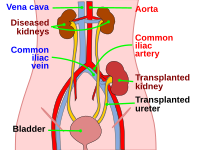
Photo from wikipedia
Background: Living kidney donors remain at low risk of end-stage kidney disease (ESKD), but the risk for obese and overweight donors is increased. The Kidney Disease Improving Global Outcomes (KDIGO)… Click to show full abstract
Background: Living kidney donors remain at low risk of end-stage kidney disease (ESKD), but the risk for obese and overweight donors is increased. The Kidney Disease Improving Global Outcomes (KDIGO) clinical guideline recommends that overweight and obese patients pursue weight loss before donation and maintain a healthy post-donation weight. Objective: To determine the trajectory of weight changes before and after living kidney donation. Design: Retrospective cohort study. Setting: The Living Kidney Donor program in the Champlain Local Health Integration Network at The Ottawa Hospital in Ottawa, Canada. Patients: The study included 151 living kidney donors who donated between January 2009 and December 2017. Measurements: Date of kidney donation, relationship to the transplant recipient, and cause of ESKD in the transplant recipient were documented. Demographic data, markers of glycemic control, and weights at the time of clinic visits were recorded. Methods: The analysis included use of paired Student’s t tests to compare mean differences in weight at kidney donation relative to the time of initial assessment and at last follow-up. Results: The median (interquartile range [IQR]) follow-up was 392 (362, 1096) days post-donation. Among donors with normal body mass index (BMI; 18.5-24.9 kg/m2), weight loss occurred before donation (62.8 ± 3.1 kg to 61.5 kg ± 2.9 kg; mean difference 1.1 ± 2.7 kg, P < .01) and did not change significantly post-donation. Among overweight/obese donors (BMI ≥25 kg/m2), weight did not change significantly pre-donation, but increased significantly post-donation (86.0 ± 2.1 kg to 88.8 ± 2.7 kg; mean difference 2.3 ± 0.9 kg, P < .0001). Limitations: The single-center design of the study limits generalizability. Conclusions: Donors with normal BMI experienced significant weight loss before donation and maintained healthy body weight post-donation. Conversely, donors with BMI ≥25 kg/m2 at donation experienced significant weight gain over 1-year post-donation. Our findings suggest the need for enhanced weight control efforts among obese and overweight kidney donors to reduce the risk of ESKD.
Journal Title: Canadian Journal of Kidney Health and Disease
Year Published: 2019
Link to full text (if available)
Share on Social Media: Sign Up to like & get
recommendations!